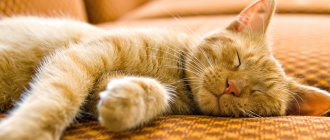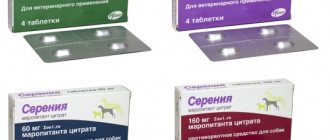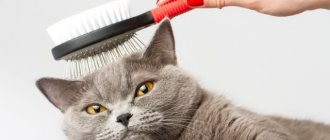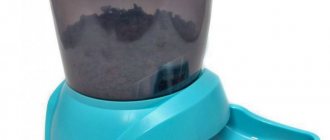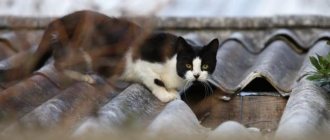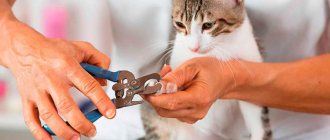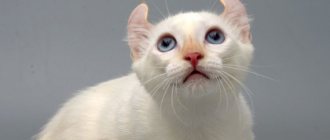Only at first glance do domestic cats seem to be a bastion of calm and indifference. But in fact, even the most balanced and lazy pets have a delicate, vulnerable psyche. A trip to the doctor, a move, a temporary foster home while the owners are on vacation, a new family member, or even a regular thunderstorm can cause them severe nervous shock. Stress provokes gastrointestinal problems and disorders in the cardiovascular and endocrine systems in animals. A caring owner always keeps a cat sedative on hand to help his friend in such situations.
Indications for the use of sedatives
It is better to agree on the possibility and necessity of using sedative medications for each specific pet with the supervising veterinarian. Like people, cats can have individual intolerances and contraindications. In addition, the psyche of each animal has varying degrees of lability.
Doctors and animal psychologists consider the following situations to be sufficient grounds for giving a sedative:
- Leaving the house and moving by any type of transport. The animal can be frightened by sounds, smells, vibration, and temperature changes. Some animals happily travel with their owners, others experience extreme fear, rushing about and screaming.
- Change of residence or foster care. It is known that cats get used not only to their owners, but also to their surroundings. They consider every corner of the house truly their territory. Naturally, in cases where an adult animal has to settle into a new home, it will need additional support. Moving is not easy for both small kittens and adult cats.
- Visiting guests or a new family member in the house. Representatives of some breeds recognize only one owner or only those people who permanently live with them. The appearance of a child or noisy guests in the house can provoke the animal into aggressiveness or, conversely, severe fright.
- A neurosis of unknown etiology, which is manifested by obsessive states such as prolonged licking, scratching, overeating, hyperactivity or frequent yawning.
- Constant desire to mark territory. An animal under stress seeks to further secure a certain habitat for itself. Males can mark corners, and females relieve themselves in corners.
- During heat, some cats become very anxious and aggressive.
- When grooming, if combing the coat, cutting, washing and drying takes a lot of time or if the pet is nervous during grooming.
- For the period of participation in exhibitions. Large crowds of people, other animals, obsessive attention - all this can negatively affect your well-being.
Also read about stress in cats.
Euthanasia at home
How to train a cat to use the toilet: instructions at home
Some owners believe that it is better to carry out the procedure at home so that the animal is less nervous. Almost all veterinary stations provide such services, with a specialist visiting on the agreed day.
The doctor will first get acquainted with the cat's medical history and only then begin to euthanize. The presence of the owner in the room is not necessary - only at his personal request.
Examination by a veterinarian at home
Important! The main problem with the home procedure is the question of the body of the deceased - in the hospital the owner will be offered cremation. Before calling a veterinarian, you can ask whether he provides additional services with the collection of a deceased cat.
Mr. Cat recommends: principle of operation
There are two types of sedatives for cats:
- Soft herbal homeopathic preparations of prolonged action. They contain extracts of soothing herbs. They carefully relieve tension from the nervous system and act cumulatively, that is, they achieve the greatest effect after a few days of regular use.
- Medicines in tablets and injections that act instantly, but at the same time have a number of side effects and are not always safe.
The use of chemicals is a last resort when the benefit outweighs the potential risk to the cat's health.
Types of sleeping pills
Cat behavior
After taking a sedative, the cat becomes lethargic, quiet, and behaves peacefully. This means that the dose is chosen correctly and there are no adverse reactions. Sometimes taking sedatives and sleeping pills for a cat is accompanied by side effects:
- nausea, vomiting;
- diarrhea;
- loss of strength, pressure, drop in temperature;
- increased salivation;
- refusal to eat.
Side effects may include other atypical pet behaviors, including hallucinations.
Sedatives and sleeping pills for cats are addictive and should not be abused. Having settled a pet in your home, you need to treat it like a family member, with patience, respect, and not put pressure on it. When a cat is loved, he understands this and will not show aggression for no reason. Special medications only help to achieve the desired cat behavior for a short time. The owners can rid him of the psychological problem themselves by transforming their own behavior.
Sleep aids
Sometimes it is not enough to simply calm your pet. A long flight or other transportation will be frightening and nerve-wracking, even in a relatively calm state. In this situation, it is advisable to give a sleeping pill designed specifically for cats. After an intramuscular injection, tablets or drops, they fall into a deep, restful sleep.
The dosage of the drug should be selected by the doctor based on the weight, breed and individual health characteristics of the pet. Such manipulation is a last resort, and an overdose is deadly.
According to the duration of action, sleeping pills are divided into:
- Gentle, short-acting, which puts the cat to sleep for 2-3 hours. They can be taken for transport or grooming.
- Medium-term muscle relaxants, analgesics and sedatives indicated in the treatment of seizures, borderline mental states or in preparation for deep anesthesia. Their effect lasts about five hours.
- Long-term narcotic drugs used in surgery and veterinary procedures. These substances are available only with a doctor's prescription and are not suitable for home use. During anesthesia, the cat must be observed by a specialist in order to prevent possible respiratory or cardiac arrest in time.
Pros and cons of euthanasia
All the advantages and disadvantages of euthanasia can be reflected in the table:
| Advantages | Flaws |
| Relieving your pet of excruciating physical suffering | Price |
| Fast and painless care | Having to make a tough decision |
| The possibility of the owner being present during the procedure, the opportunity to say goodbye | |
| Possibility to carry out euthanasia at home by inviting a veterinarian |
Recommended sedatives
There are sedatives for cats that have worked well with owners and are approved by veterinarians.
Herbal preparations
Herbal preparations with a mild and gentle effect on the nervous system of pets include:
- Dragee Relax Plus - contains lemon balm and motherwort extracts, is non-addictive, calms the cat, helps eliminate spasms and unpleasant symptoms of seasickness.
- Stop stress drops with nootropics and sedative essential oils. This remedy is recommended for aggressive, restless animals prone to chronic stress and inappropriate behavior in it.
- Fitex drops are a liquid based on medicinal herbs. Not recommended for adults with hypotension and small kittens.
- Zoomir anti-stress tablets contain not only a sedative, but also vitamins, minerals and micronutrients that have a beneficial effect on the cat’s well-being.
- Feliway spray with artificial pheromone - gently soothes, but has no odor discernible to the human sense of smell.
- Fospasim injection liquid and drops are based on natural ingredients - they have a quick effect and are suitable for cases when the cat has to travel for a long time.
- Tablets and tincture Kot Bayun are a natural remedy with prolonged action. Contraindicated for kittens under one year of age.
- Serene Um dietary supplement contains micronutrients and amino acids that have a beneficial effect on the nervous system of cats and is prescribed as a supporting agent during adaptation or a long course of treatment.
Synthetic products
Synthetic sedatives should only be used after consultation with a veterinarian. He will select the optimal dosage and course duration.
Chemical drugs include:
- Xylazine is a derivative of thiazine, it quickly calms a cat in a state of acute stress, but has many contraindications.
- Amitriptyline for intravenous and intramuscular injections - for emergency assistance to animals in an attack of aggression or during a panic attack.
- Buspirone in injections and tablets is suitable for treating pets in a state of long-term neurosis and obsessive states.
- Diazepam is a fast-acting sedative for animals with hyperactivity and nervous overexcitation.
When not to take sedative medications
Sedatives and sleeping pills for cats, even of plant origin, have individual indications and should not be used in the following cases:
- during pregnancy and lactation;
- at low pressure;
- under the age of 1 year;
- for diseases of the kidneys, liver, diabetes.
Cats have an individual intolerance to some components of the drug, so it cannot be treated uncontrolled.
If after treatment with the chosen drug there are no changes in the cat’s behavior within 2 weeks, you should contact your veterinarian for a new prescription.
Valerian
There is a myth that valerian has a calming effect on the cat's body. This is not so, the medicine contains an active substance identical to the pheromones that are produced in cats during sexual arousal. Therefore, valerian does not calm cats, but excites them. In addition, the medicine is addictive and addictive.
Some sedative medications contain valerian extract in negligible doses that will not cause increased anxiety in your pet.
Sleeping pills
Putting an animal into medicated sleep must be approached with a high degree of responsibility. You must understand that this is an emergency measure and it is better to resort to it under the supervision of a doctor.
The most commonly used means include:
- Ventranquil is a powerful tranquilizer that is often used to transport felines. It not only soothes you for a long time, but also helps cope with motion sickness.
- Butorphanol is a sleeping pill that can help an animal in the acute period of neurological diseases, with phobias and obsessive-compulsive disorder.
- Meditin is used for sedation and gentle euthanization before intravenous or mask anesthesia and surgical interventions, as well as after them for pain relief, muscle relaxation and sedation.
- Relanium is a remedy known in human psychiatry. A powerful drug used in emergency situations for large and healthy cats.
Possible causes of stress
In what stressful situations should you resort to drugs:
- change of residence, repairs, rearrangement of furniture;
- purchasing a new type of food or litter for the tray;
- even temporary absence or separation from the owners;
- visit of guests;
- the arrival of a new pet or child in the family;
- travel;
- visiting a veterinary clinic or groomer;
- exhibitions, any events;
- walking;
- hormonal surge.
All these seemingly insignificant events can unsettle even a calm animal. In some cases, for example, when visiting guests, you can do without taking sedatives. You need to worry about creating a safe, secluded area for the cat in advance. A house or basket placed in a quiet place will do the job perfectly.
More traumatic events can be moving, traveling, or medical procedures. In this case, medications will help the pet survive them without consequences for the nervous system. In some cats, estrus is severe and causes them discomfort, so drops in this case will not be superfluous.
Side effects
You cannot rely on sedatives as a panacea or remedy for any stress in a cat. Just like humans, pets' nervous systems are adaptable. Sometimes you need to let your pet experience frustration and learn life lessons from it. Helping a kitten with your attention, affection and care means laying a brick in the foundation of reverent affection and friendship.
In addition, any, even the mildest, medicine has a number of contraindications and side effects. They can cause allergies or addiction, disrupt intestinal motility, and provoke the development of gastritis.
The stronger the drug, the greater the likelihood of its negative effect on the heart, blood vessels and nerve fiber.
There is always a risk of unpredictable individual reaction and death. It is advisable to consult a veterinarian before use.
Sleeping pneumatics
Let's start with the most primitive, but very popular and quite effective device.
This “wind-throwing device” complete with “UVYSH-1m” syringes is nothing more than an enlarged modification of school tubes for spitting balls of chewed paper and homemade darts with needles. Well, or a plastic analogue of exotic sarbakans.
The “actual fire” distance is up to 15 meters.
We should immediately briefly talk about flying injection syringes that self-cock when moving along the barrel. They differ mainly in the amount of drug (from rabbit to bear or moose), ballistic characteristics and pusher drive - spring or compressed gas.
You can shoot them not only from a blowpipe. Taking a look at the photographs below, many air rifle owners will begin to look at their “toy” rifles differently.
This is a “UVYSH-651m” kit, consisting of a “Veterinarian-651KS” thrower and a set of syringes. The recommended range of use is up to 10 m, the number of shots on one can is up to 50.
It is not difficult to guess that, in fact, we are dealing with the good old Izhevsk gas-cylinder (CO2) MP-651K, only single-shot and 12 mm caliber. Compare with the prototype:
And this is a pneumatic gun with a larger canister—the “Sanitar” throwing device. It has a range of up to 30 m, and the number of shots has increased to hundreds.
There are also imported analogues. For example, Dan-Inject Model JM Special.
Since neither I nor you, dear readers, are professionals in this field and are not going to make money from this, I don’t see much point in stopping at rifles that cost tens of thousands of rubles.
And finally, even paintball markers are successfully used for remote immobilization purposes.
Most of the devices described above are highly specialized, with calibers ranging from 6.35 mm (.25) to 13 and even 21 mm. And therefore it goes beyond the interests of ordinary amateurs and owners of unlicensed pneumatics of 4.5 mm caliber (.177). But not everything is so bad - rejoice, owners of budget Izhevsk “Murkas”!
Yes, in the photo is MP-512, in this version proudly called the “Lider-3pd veterinary gun set.” Damage range up to 30 meters.
The photo below shows us another old friend - MP-53M, again under the sonorous name “Veterinary device LEAder-1pm”. The firing distance, as expected, is shorter.
These are standard products with declared projectile speeds of 170 and 110 m/s. With no less success, their place could be “Hatsan”, “Gamo”, “Diana” - any spring-piston air rifle or pistol with a broken barrel. Weapons with underbarrel/side cocking or PCP, due to the presence of “clips”, drums and other design features, are mostly not suitable, since the dimensions of bullets and throwing darts are very different.
And here are the darts themselves. On average the price is about 40 rubles per piece. All are branded “Leader”, all are 4.5 mm caliber, differ in ballistic characteristics and properties of the active composition.
For example, “Leader-d” (below) has half the time before the immobilizing suspension begins to work than those that use a hardening paste. And the accuracy, by the way, is higher due to the modified design.
Literally until recently, in addition to owners of PCP and rifles with a fixed barrel, owners of short-barreled gas-cylinder weapons, the drums and magazines of which simply did not fit the dimensions of the darts, were also subject to a kind of “discrimination.” Everything changed with the advent of revolvers with so-called false cartridges (see article “Short barrel”).
The photo shows the LEADER-4pgl kit. This “...hl” in its name seems to come from the company -, but any analogue will do, be it “Cybergan”, “Dan Wesson” or “Smersh”. The undoubted advantage of such a weapon immediately catches your eye - multi-charge capability. As well as a minus - a tiny dart, which means a small amount of active ingredient. Taking into account the known characteristics of such revolvers, we can say that they are designed for short shooting distances and for stray cats and small dogs. However, these animals, no less than wild ones, need treatment and evacuation to holding centers and shelters. And the device itself, if you have shooting skills, will allow you to work in a flock.
Rules for taking sedatives
At all stages of sedative therapy, it is necessary to monitor the cat’s condition and follow a number of safety recommendations:
- Carefully read the instructions, analyze the composition, and monitor the expiration date.
- Do not self-medicate and do not exceed the dosage prescribed by your doctor.
- Provide your cat with sufficient fresh air, especially after using chemical sleeping pills.
- Many drugs lead to rapid dehydration, so the animal should be given water more often.
- Monitor the general condition of the pet. If alarming symptoms are detected, such as convulsions, drooling, foaming at the mouth, a drop in body temperature, pulse, or respiratory depression, you need to take your pet to a veterinary hospital as soon as possible.
1111
Cost of euthanasia in a veterinary clinic
How much does it cost to euthanize a sick cat? Price depends:
- depending on the regional location of the clinic - in small towns the cost is lower than in big cities;
- veterinary hospital level;
- pet's body weight;
- additional services - travel to home conditions, subsequent cremation.
The average price varies from 500 to 5000 rubles; in Moscow, the average cost of the procedure is about 2750 rubles. A doctor’s visit to your home will increase the total cost by 1000-1500 rubles, cremation will add 500 or more rubles.
Euthanasia of an incurable cat is not murder, but an opportunity for the animal to stop suffering. The procedure will stop the suffering of the animal and its owner - the latter will not worry about his own helplessness.
